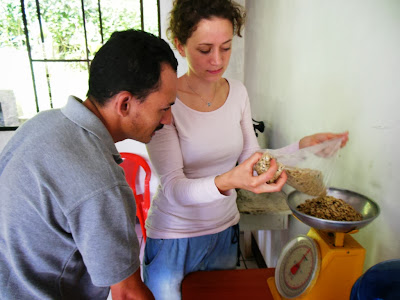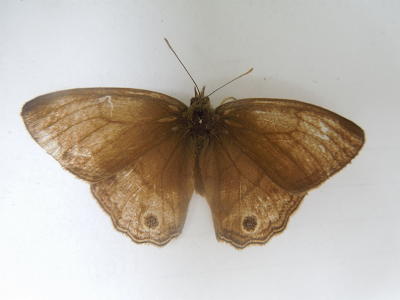Quality control in a coffee farm culminates in the most tempting of all jobs: coffee tasting. At
The Mountain School,
Spanish students learn about the coffee production process, including how the coffee is taste-tested professionally. Coffee tasting is still an art, but a fine art, with diligent procedures involved in the tasting process. Here are some photos of the coffee taster, Nelson McKuen, explaining the process to our group.
When coffee leaves the wet mill, there is still a papery husk covering the bean, having the pulpy outer "cherry" removed and washed. Samples taken from the coffee are taken, measured and stored for documentation purposes.
In the quality control laboratory, the coffee is dried under controlled conditions, in a cabinet dryer.
 |
| Coffee drying in a cabinet in the quality control laboratory. Photo by Tania Company. |
We gave the green coffee a taste-it doesn't taste like anything at all. Someone wondered aloud how anyone ever would have discovered the great taste of coffee, given that the raw product has no strong flavor.
 |
| Nelson shows us how the coffee from the wet mill is dried before testing and storing samples. Photo by Tania Company. |
As in any factory, there are lots of tests made by the quality control laboratory, including the quantity of "reject" material, moisture, and other things, but we were wanting to taste the coffee!
 |
| A sample of coffee was wieghed before roasting for a taste test. Photo Tania Company. |
The coffee roasted in the laboratory smelled wonderful. We were all excited before even drinking any coffee. Then someone reminded us that the taste test did not involved drinking coffee. To the contrary, the tasted coffee is spat out by the professional taster. How can they do that?
 |
| Freshly roasted coffee has an incomparable flavor. Photo Tania Company. |
Nelson ground the roasted coffee and placed a spoonful in each of several cups with hot water. The foam was removed by hand, then sampling began. Coffee makes
The Mountain School even better!
 |
| Nelson guides each participant through the tasting process. |
Our results, however, were abysmal. None of our group recognized the differences between the different lots of coffee. Perhaps our group was anxious to drink coffee, not just swish it around in our mouths and then spit it out. Gaia Program director
Jeffrey McCrary gave the coffee a taste, and yep, it was good.
 |
| Tasting coffees is diligent work. Photo Tania Company. |
The coffee tasting and quality control processes are essential to any high quality coffee farm. We learned more about how good coffee is made by participating.
 |
| Click on the "escudo" to contact us. |














